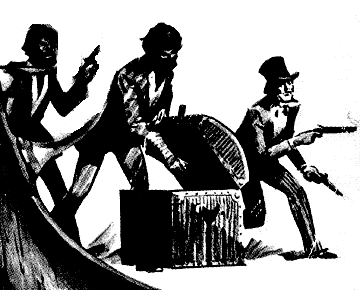

[The Black Coats]


[The
Black Coats]
A TIMELINE
"I am Gold. I am Wealth. I am Power.
You must not compare me to Kings or Emperors
or anyone who lives upon the Earth.
I have only two rivals: one in Heaven and the other in Hell.
For only God, if God exists, and Satan, if Satan exists, can say like I do:
Everything in the world is mine, for I own it ALL."
(The Colonel - Les Compagnons du Trésor - Chapter XXVI)

Discrepancies
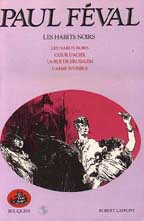 As he wrote Les Habits Noirs over a thirteen year period,
from 1863 to 1875, Paul Féval introduced new story elements that sometimes contradicted earlier facts; he
also retroactively incorporated in his saga several of his earlier novels, in particular Les Compagnons du Silence penned in 1857. As a result,
while Féval remained generally consistent with respect to his facts, genealogies, who did what to whom,
etc. his chronology, or the dates given for a same event in different books, occasionally conflicted.
As he wrote Les Habits Noirs over a thirteen year period,
from 1863 to 1875, Paul Féval introduced new story elements that sometimes contradicted earlier facts; he
also retroactively incorporated in his saga several of his earlier novels, in particular Les Compagnons du Silence penned in 1857. As a result,
while Féval remained generally consistent with respect to his facts, genealogies, who did what to whom,
etc. his chronology, or the dates given for a same event in different books, occasionally conflicted.
The three major discrepancies (not a huge number, considering that we are talking about 5000 pages of material)
are:
1. The Colonel's Birth and Death: The
Colonel's birthdate is first given as c. 1722, but the date carved on his tombstone according to Volume 7 is 1739.
This is a minor point and we are inclined to choose the latter date. His death is a trickier matter. In Volume
1, Féval showed the Colonel dying in October 1842. In Volume 6, Féval reveals that the Colonel was,
in reality, killed by his grand-son Julian Bozzo-Corona
in mid-1841. Julian then assumed the identity of Cavalier Mora, but occasionally re-emerged as the Colonel. At the end of Volume 6, Féval tells us
that Reynier, Julian's son, killed Julian;
Reynier then goes on to marry Irène Carpentier,
and nothing more is written about them thereafter. What is troubling is that in Volume 7, the Cavalier
Mora returns, again impersonating the Colonel (just as before), again a young
man pretending to be a very old man, again in possession of the treasure, again fencing with the High Council which
is now led by Cadet L'Amour. So who is
this new Mora?
There are only two possibilities:
(i) we disregard what Féval wrote, and assume (against every evidence to the contrary) that Julian survived the cataclysmic conclusion of Volume 6 and that he is the Mora of Volume 7 up to his old tricks;
(ii) we postulate that Reynier somehow lost Irène, and decided to become the new Mora/Colonel.
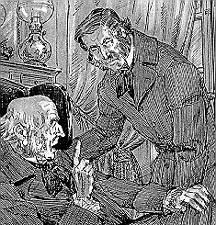 We choose to second possibility because in Volume 7, the new Mora appears
to be in friendly terms with the heroic Dr. Lenoir,
a sworn enemy of the Black Coats, and further, his actions bring about the destruction of the evil Cadet L'Amour and his gang. All this seems consistent
with Reynier's character.
We choose to second possibility because in Volume 7, the new Mora appears
to be in friendly terms with the heroic Dr. Lenoir,
a sworn enemy of the Black Coats, and further, his actions bring about the destruction of the evil Cadet L'Amour and his gang. All this seems consistent
with Reynier's character.
2. The Death of Marguerite: Marguerite Sadoulas,
Countess of Clare, is unambiguously shot by her husband, Count Joulo Bréhut
de Clare, at the end of Volume 2, after being exposed and defeated by Roland Fitz-Roy de Clare, in a story clearly stated to
take place in 1843. Yet, Marguerite is present during the events of Volume 7 in 1853, ten years later. She is not
part of the Black Silk Hoods in 1866,
which refers to her death. The logical inference is therefore that she died sometimes between 1853 and 1866, not
in 1843.
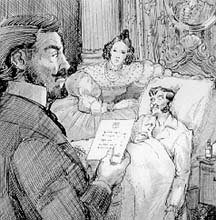 The only possible solution to this conundrum, therefore, is to disregard what Féval
wrote, and pretend (against every evidence to the contrary!) that the woman who was shot in 1843 (if there was
any shooting indeed!) was not Marguerite,
and that somehow she was pardoned, forgiven, ignored, or more generally allowed to continue to go on as previously
by Roland (because she is clearly still using both her name and title ten years later in 1853). Obviously, no good
deed goes unpunished since Roland and
his wife Nita d'Eppstein were both killed
by the Black Coats at a later date.
The only possible solution to this conundrum, therefore, is to disregard what Féval
wrote, and pretend (against every evidence to the contrary!) that the woman who was shot in 1843 (if there was
any shooting indeed!) was not Marguerite,
and that somehow she was pardoned, forgiven, ignored, or more generally allowed to continue to go on as previously
by Roland (because she is clearly still using both her name and title ten years later in 1853). Obviously, no good
deed goes unpunished since Roland and
his wife Nita d'Eppstein were both killed
by the Black Coats at a later date.
3. The Colonel's Family: This is a particularly
tangled knot to unravel. Féval tried to retroactively make Les
Compagnons du Silence fit within the chronology of Les Habits Noirs but seems to have lost his thread somewhere...
In Les Compagnons du Silence,
Mario de Monteleone has three children:
- Coriolani, born in 1801, who eventually
returns as Bel Demonio to avenge his father's
death in 1815, and dies on the Vesuvius in 1823.
- Julian, born in 1805.
- Celeste, born in 1807.
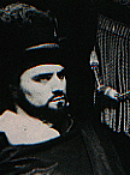 In Volume 6 of Les Habits Noirs, it is implied that the Colonel
was Mario's father and that he has three
GRAND-children:
In Volume 6 of Les Habits Noirs, it is implied that the Colonel
was Mario's father and that he has three
GRAND-children:
- Coriolani, birth year unstated, who
now dies in 1839, trying to assassinate the Colonel.
- Julian, who
now claims to have been born 6 years after the Coriolani
above, who eventually kills the Colonel in 1841 and goes on impersonate him. Julian is the same Julian
who is Mario's son.
- Francesca (aka Fanchette), born in 1819 or 1820, who is not Mario's daughter, Celeste
(she would be too old). Considering her name, we theorize that she is the daughter of Francesca
Policeni, the Colonel's daughter.
So we have no choice but switch Coriolanis (as it were) and assume that the Coriolani who died trying to kill the Colonel
in 1839 was the one who was Mario's son
(and the Colonel's GRAND-son) from
Les Compagnons.
We have tried to make all the pieces fit, but clearly making certain choices based on certain facts means contradicting
other facts.
A Brief History of the Black Coats
At the beginning, there is the dreaded Camorra,
a proto-Mafia of country brigands who terrorize the Kingdom of Naples, Sicily and Sardinia in Southern italy, and
whose origins remain shrouded in history.
1625
In Southern Italy, near Spolete, François
Vitelli, designated heir of the Prince
of Monteleone, is murdered by his cousin Ercole
Vitelli under the eyes of his son, Andrea
Vitelli.
1635
Andrea Vitelli returns as Bel Demonio, leader of the Camorra, to avenge his father's death. This also introduces the Brothers
(or Brotherhood) of Mercy, a religious order who serves as a cover for the
Camorra.
1655
Presumed death of Andrea Vitelli.
Then, in 1739 (or thereabout), the Colonel is born. Who is he?
 Féval states
that the Colonel is the historical "Fra Diavolo",
a man named, or at least using the alias of, Michele Pezza or Pozzo or Bozzo. Fra Diavolo became the subject of an 1830 opera by Scribe, music by Auber (adapted as The Devil's Brother starring Laurel & Hardy in
1933). He was reportedly hung by General Hugo
(Victor Hugo's father) in Naples in 1806.
Féval states
that the Colonel is the historical "Fra Diavolo",
a man named, or at least using the alias of, Michele Pezza or Pozzo or Bozzo. Fra Diavolo became the subject of an 1830 opera by Scribe, music by Auber (adapted as The Devil's Brother starring Laurel & Hardy in
1933). He was reportedly hung by General Hugo
(Victor Hugo's father) in Naples in 1806.
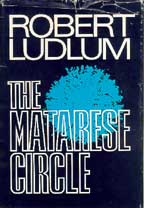 According
to Féval, Fra Diavolo is the title
worn by the leader of the Brothers of Mercy.
Féval equates Fra Diavolo with
Bel Demonio and, according to him, he
is also known as il Padre d'Ogni, the
All-Father (Godfather). Bozzo as Fra Diavolo was the leader of the Bastia crime family
of the Bozzo-Corona in Corsica, who is
connected to the Reni family of Sartene,
the Gioja of Naples and others, unnamed,
in Sicily (such as the Corleones). No
doubt they are also connected to the Matarese
and Drago families of Corsica as well.
According
to Féval, Fra Diavolo is the title
worn by the leader of the Brothers of Mercy.
Féval equates Fra Diavolo with
Bel Demonio and, according to him, he
is also known as il Padre d'Ogni, the
All-Father (Godfather). Bozzo as Fra Diavolo was the leader of the Bastia crime family
of the Bozzo-Corona in Corsica, who is
connected to the Reni family of Sartene,
the Gioja of Naples and others, unnamed,
in Sicily (such as the Corleones). No
doubt they are also connected to the Matarese
and Drago families of Corsica as well.
Things begin to change at the end of the 18th century and the beginning of the 19th century when, under Napoleon, the French invaded Southern Italy and the Kingdom
of Naples. This is definitely to be connected to the events that happened at Wold
Newton in 1795
and which are studied in our article on The Conspiracy.
The Colonel's companion at the World Newton meeting of 1795 was one Albert Lecoq,
a member of the High Council. Soon after, Albert Lecoq became the father of Lecoq
de la Perière (aka Toulonnais l'Amitié, first name unknown) born sometimes between 1795 and 1803 according
to Feval, who became the Colonel's right-hand man and presumed heir. The identity of the woman who was Albert Lecoq's
wife and Lecoq de la Perière's
mother is unknown. We, however, have reason to believe she was Anne de Breuil, the unnamed "beautiful woman" of the 1807 Council, and a descendent of the notorious
Anne de Breuil who fought d'Artagnan as "Milady".
Lecoq de la Perière, in turn, became the father of the notorious Monsieur Lecoq c. 1830 (first name also unknown). While the identity of
the mother remains unknown, there are reasons to believe it may have been Marguerite
Sadoulas, another member of the High Council
Féval tells us in Volume 7 that either in 1803
or 1807 (Feval gives conflicting dates
in Volumes 3 and 7, but 1807 is more credible, right after Fra Diavolo's capture by General Hugo
in Naples), the twelve members of the High Council of the Brotherhood met with the Colonel and his daughter, the beautiful Francesca Policeni, to decide how to deal with changing times.
 At
a meeting held at the Convent in Sartene a month later, three Members of the High Council chose to split the treasure
and leave. They were executed. Their places were taken by Doctor Samuel (originally from Austria but now living in France), Law Professor Portal-Girard (who came up with the method of "paying the Law", i.e. framing an innocent for their
crimes), and an unnamed "beautiful woman" (who cannot be Marguerite
Sadoulas because she was born in 1812). She may have been Albert Lecoq's new wife. Another new addition to the Council
at that time was Englishman Nicholas Smith,
an unidentified Priest, and a Sicilian
named Gian-Paolo (who all died with Coriolani during the revolt of 1839).
At
a meeting held at the Convent in Sartene a month later, three Members of the High Council chose to split the treasure
and leave. They were executed. Their places were taken by Doctor Samuel (originally from Austria but now living in France), Law Professor Portal-Girard (who came up with the method of "paying the Law", i.e. framing an innocent for their
crimes), and an unnamed "beautiful woman" (who cannot be Marguerite
Sadoulas because she was born in 1812). She may have been Albert Lecoq's new wife. Another new addition to the Council
at that time was Englishman Nicholas Smith,
an unidentified Priest, and a Sicilian
named Gian-Paolo (who all died with Coriolani during the revolt of 1839).
This is when the Brotherhood became first
known as the Veste Nere (Black Coats)
in Italy, then spread throughout Europe where they became known as the Gentlemen
of the Night and the Black Coats in England, the Habits Noirs
in France, and the Rozenkreuz in Germany.
 Monteleone: The beginning of the 19th century is also
when the Monteleone family (not mentioned
since Bel Demonio) resurfaces
in our story. Here are the key dates and events given by Féval in Les
Compagnons du Silence:
Monteleone: The beginning of the 19th century is also
when the Monteleone family (not mentioned
since Bel Demonio) resurfaces
in our story. Here are the key dates and events given by Féval in Les
Compagnons du Silence:
1801
Mario de Monteleone (birth date unknown, c. 1770?) married Maria d'Amalfi. Birth of their first son Fulvio Coriolani. Based on Féval's sometimes contradictory
information, we shall affirm here that Mario was, in fact, the Colonel's illegitimate son, from an affair between the Colonel and the wife of the previous Count
of Monteleone.
This would make Fulvio Coriolani the Colonel's
grand-son, and therefore the one
who tried to assassinate him in 1839. However, he would NOT be the same Coriolani who returned to avenge Mario's death (see below), who was the Colonel's son (not grand-son).
If the Colonel fathered Mario with a Monteleone woman, who was the OTHER woman who was the mother to the other Coriolani, and likely the beautiful Francesca Policeni as well? We have theorized in our article on the lineages of other Wold
Newton families, The
Tangled Web, that this woman was Anselma
de Felipone (whom we made up), who also fathered Paolo
de Felipone who killed Armand de Kerghaz in 1812 (see Rocambole) and died in 1843.
1805
In Naples, birth of Julian de Monteleone,
second son of Mario de Monteleone, the
man who eventually grows up to kill the Colonel.
In Sartene, birth of Giovanna Maria Reni,
related to the Bozzo-Corona of Bastia.
She later became Julie Maynotte, and then
Julie Schwartz in Volume 1.
1806
Year of the alleged hanging of Fra Daviolo
by General Hugo in Naples.
1807
Birth of Celeste de Monteleone, daughter
and third child of Mario de Monteleone.
This is the year of the Sartene meeting of the High Council of the Brothers
of Mercy, when they became the Veste Nere and embarked upon their plans of international expansion. A very important date indeed.
1808.
In Naples, Mario de Monteleone creates the Iron Knights
or Companions of Silence to fight against
Napoleon and joins forces with Ferdinand of Bourbon.
1810-1813
Rosenkreuz (German Black Coats) activities
in Germany and Poland, as revealed in Jean Diable.
JEAN DIABLE IS NOW
AVAILABLE FROM BLACK COAT PRESS
1812
French army Lieutenant Sadoulas marries a Spanish woman from Aragon and fathers Marguerite
Sadoulas, later Marguerite of Bougogne, later Countess of Clare and future
member of the High Council of the Black Coats.
1815
In London in August, Helen Brown and her son, Tom Brown,
are arrested in a salon in Oxford Street, taken to Newgate, then deported to Australia. Meanwhile, in Italy, Ferdinand of Bourbon takes over the Kingdom of Naples.
In October, Mario de Monteleone returns
to Sicily. Meanwhile, Joachim Murat tries
to take over the Kingdom of Naples from Ferdinand,
but is defeated. He finds refuge with Mario.
Ferdinand has both men arrested and executed
at the Castle of Pizzo on 15 November.
 Based on information provided by Féval, we know that Mario was the Colonel's
son; we also know that his death was the result of a betrayal. Finally, we also know that in Volume 6 (Chap.III),
the Colonel says that that "he spent eleven days and eleven nights hidden in the Castle of Monteleone during
the days of Murat". So we theorize that Mario's death was the result of yet another scheme by the Colonel
to kill his own sons before they could kill him.
Based on information provided by Féval, we know that Mario was the Colonel's
son; we also know that his death was the result of a betrayal. Finally, we also know that in Volume 6 (Chap.III),
the Colonel says that that "he spent eleven days and eleven nights hidden in the Castle of Monteleone during
the days of Murat". So we theorize that Mario's death was the result of yet another scheme by the Colonel
to kill his own sons before they could kill him.
1817
In London, this is the year during which the events narrated in Jean
Diable take place. Among other things, we learn that Tom
Brown (who also used the alias of "James Davy"), before returning
to London and becoming the new John Devil,
had a secret meeting with Napoleon in
Saint-Helens. Eventually, he is unmasked by Gregory Temple and executed. Féval also records that, at some point between 1815 and 1821, Fergus O'Breane stopped in Saint-Helens and met with Napoleon
for four hours.
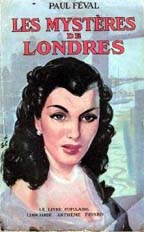 We believe that
Tom Brown and Fergus
O'Breane met Napoleon at the same time, acting on behalf of the Conspiracy. What transpired, we do not know for certain, but we believe that (a) Napoleon gave them instructions
to revenge himself against England; and (b) they may have poisoned him (many modern-day historians believe the
Emperor was poisoned), or maybe organized his escape to the New World (as others believe)?
We believe that
Tom Brown and Fergus
O'Breane met Napoleon at the same time, acting on behalf of the Conspiracy. What transpired, we do not know for certain, but we believe that (a) Napoleon gave them instructions
to revenge himself against England; and (b) they may have poisoned him (many modern-day historians believe the
Emperor was poisoned), or maybe organized his escape to the New World (as others believe)?
1818
The Colonel
relocates his headquarters to Paris,in a Hotel Particulier located Rue Thérèse. He begins to pose
as a philanthropist. Meanwhile, the Habits Noirs
take over the French underworld and become very active throughout France.
1820
Birth of Francesca (aka Fanchette), the Colonel's grand-daughter. Fanchette is likely the daughter of Francesca
Policeni and her husband. Considering the various allusions made by Féval
to the recurring betrayals of the High Council, and their execution by the Colonel and his henchman, Coyatier a.k.a. the Marchef (whose hand even other criminals are afraid to shake), it is tempting to assume that both
parents died in one of the Black Coats' purges or internecine fights.
Also birth of Reynier, the son of Julian Bozzo-Corona (then aged 15) and a gypsy girl named
Zorah. The baby was taken away before
Julian could kill him, as per the horrible family tradition.
1823
Since Mario de Monteleone's death in 1815, the Companions of Silence had grown into a Napolitan crime ring and had become part of the Veste
Nere. In 1823, a mysterious stranger walks into their midst, claiming to be
Bel Demonio. In reality he is the wealthy
Prince Coriolani, who takes over the criminal
society, defying the traps laid for him by the Chief of the Napolitan Royal Police, Johann
Spurzheim.
This Coriolani believes himself to be
Mario's eldest son, and seeks to avenge
his father, but as we have seen, it is a deception arranged by the wily Colonel (Fra Diavolo). This
Coriolani / Bel
Demonio is in reality the Colonel's own son from Anselma
de Felipone. In any event, this Coriolani (like Julian) also falls in love with a gypsy girl, and eventually dies in the flames of the Vesuvius.
 1825-26
1825-26
This marks the debut of the events narrated in Volume 1 - Les Habits Noirs. Jean-Baptiste
Schwartz, a future member of the High Council, arrives in Caen, Normandy.
A daring robbery is organized by the Black Coats,masterminded by Lecoq. Metal worker André Maynotte
is framed and arrested. His wife, Julie
(see 1805) eventually comes to believe
him dead and remarries Schwartz.
1830
Meanwhile, Marguerite de Bourgogne is living with the brutish Count Joulou du Brehut de Clare, a member of that very wealthy family. Her ambition and her life of crime enables her to meet
the Black Coats. She likely had an affair with Lecoq de la Perière and gave birth to Monsieur Lecoq
that year or thereabout.
One of Marguerite's lovers was Julien Lenoir,
the brother of young, gifted and very moral Dr. Abel Lenoir. Julien is killed in a duel by Count Joulou, thus beginning the mortal feud between Dr. Lenoir and the Black Coats.
In the meantime, J.-B. Schwartz has become
a powerful banker and a member of the High Council as well. In addition to Lecoq, Marguerite, and Schwartz, the
member of the High Council residing in Paris include Dr. Samuel, Law Professor Portal-Girard,
a fake pretender to the throne of Louis XVII known simply as the Prince, the Abott Franceschi,
and the Count Corona (who later marries
Fanchette). The Italian viscount Annibal Giona is seen visiting and paying his respects
to the All-Father.
In London, 1830-1836 is when Fergus O'Breane
rules the Gentlemen of the Night under
the alias of Marquis de Rio Santo, as
narrated in Les Mystères de Londres.
THE STAGE PLAY
VERSION OF MES MYSTERES DE LONDRES IS NOW AVAILABLE FROM BLACK COAT PRESS
1832
This marks the debut of the events narrated in Volume 2 - Coeur
d'Acier, which is the story of Marguerite's attempt to steal the Clare Inheritance. She soon marries Count
Joulo and becomes Countess of Clare. She becomes a member of the High Council
and one of the Colonel's favorites. Introductions
of the crooked solicitor clerk Comayrol
and the deceptively evil "Goodman" Jaffret.
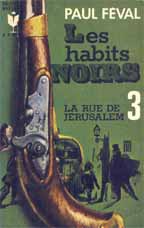 1834
1834
This marks the debut of the events narrated in Volume 3 - La
Rue de Jerusalem, in which the Black Coats plan to use the Prince (Nicolas) to steal the fortune of Mathurine Goret de Champmas. Introduction of Clampin, nicknamed Pistolet. Pistolet is ambitious, dynamic, and clever. He is an Archie Goodwin or Rouletabille-type, and likes to use modern methods of
investigation. He keeps files on everyone, writes reports which he sends to Government Officials, hoping to be
hired to run the Sureté (so convinced he is of his abilities).
LA RUE DE JERUSALEM
IS NOW AVAILABLE FROM BLACK COAT PRESS
It is also the year when the Colonel enlists
the help of destitute architect Vincent Carpentier
to build a secret room to house his treasure in his Hotel Particulier. Vincent is the father of Irene and the adoptive father of Reynier (see 1820).
1836
Fanchette marries the Count Corona (whom she does not love).
1838
This year sees the conclusion of the adventure narrated in Volume 3 - La
Rue de Jerusalem. Nicolas betrays the Colonel, and is arrested. At the end of the year, he escapes, but Coyatier seals him alive inside a wall.
 This is also the year during which the events narrated in Volume 4 - L'Arme Invisible take place. In the fall of 1838, the
Colonel becomes concerned about young magistrate Remy d'Arx who is investigating the Black Coats. He decides to use wjat he calls his "invisible
weapon" against him. That turns out to be Fleurette,
a young girl raised by Leocadie Samayoux,
aka Maman Leo. Remy falls in love with
Fleurette, but then discovers that she is his biological sister, and commits suicide. In the second half of the
book (Maman Leo), Fleurette,
Maman Leo and her friend, Echalot, strike
back at the Black Coats. By year-end, the Colonel suprisingly helps Fleurette save her true love, young Maurice, who was framed by the Black Coats and was about
to be sent to the gallows. Fleurette and Maurice leave France, never to return.
This is also the year during which the events narrated in Volume 4 - L'Arme Invisible take place. In the fall of 1838, the
Colonel becomes concerned about young magistrate Remy d'Arx who is investigating the Black Coats. He decides to use wjat he calls his "invisible
weapon" against him. That turns out to be Fleurette,
a young girl raised by Leocadie Samayoux,
aka Maman Leo. Remy falls in love with
Fleurette, but then discovers that she is his biological sister, and commits suicide. In the second half of the
book (Maman Leo), Fleurette,
Maman Leo and her friend, Echalot, strike
back at the Black Coats. By year-end, the Colonel suprisingly helps Fleurette save her true love, young Maurice, who was framed by the Black Coats and was about
to be sent to the gallows. Fleurette and Maurice leave France, never to return.
Finally, at the end of 1838, the Colonel
also thwarts a scheme by several members of the High Council to kill him and steal his treasure. Another Pretender and Portal-Girard are killed. Dr. Samuel
barely escapes with his life. Lecoq wisely
chooses to remain faithful to the Colonel.
L'ARME INVISIBLE
IS NOW AVAILABLE FROM BLACK COAT PRESS
1839
The Colonel thwarts another plot against him in Sartene. This time, the plotters are his own grand-son Coriolani (the son of Mario
de Monteleone), Nicholas Smith, Gian-Paolo and the
unnamed Priest. They all perish under
a rock slide triggered by Coyatier.
1840
Birth of Saladin, whose father is Amédée Similor (one of the Black Coats'
henchmen) and mother Ida Corbeau.
 1841
1841
This is the year during which the events narrated in Volume 6 - Les
Compagnons du Trésor take place. The execution of the traitorous members
of the High Council in 1838 and 1839 did not stop the other members to plot again to steal the treasure, now hidden
in the secret chamber built by Vincent Carpentier
in 1834. Lecoq, Marguerite, Dr. Samuel, Italian
viscount Annibal Gioja, Count Corona, a new Prince, and two others now form a loose cabal calling itself the "Companions
of the Treasure".
But Vincent Carpentier, now a famous architect,
wants the treasure too. Meanwhile, his adopted son, Reynier, now in his early 20ies, lives in Paris as an artist.
The Colonel and the "Companions" focus too much of their attention on Vincent. As a result, they miss
the return of Julian Bozzo-Corona, Coriolani's brother and the Colonel's other grand-son.
Julian succeeds in killing the Colonel, perpetuating the family's strange ritualistic tradition, and unwittingly
saving Vincent's life. He then disguises himself as, and becomes, a new Colonel, fooling everyone, except Vincent
who was witness to both the murder and the transformation. Vincent is forced to flee the wrath of the Black Coats.
Julian has the Colonel's body embalmed.
Eventually, he finds the Treasure and convers it into a handful of papers, with millions, but which fit easily
inside a small box.
1842
André Maynotte has returned and,
under the guise of "Trois-Pattes", is now in the employ of Lecoq and is plotting his revenge.
In September, Julian decides that he no longer needs to impersonate the Colonel. He fakes the Colonel's death in
October, surrounded by the High Council, and has the embalmed corpse buried at the Père Lachaise cemetery.
Then, Julian assumes the identity of Cavalier Mora. The Scapulary falls into the hands of Francesca,
who gives it to Maynotte.
Count Corona kills Francesca in a vain attempt to learn the secret of the treasure. He then flees to Sartene, where he
is, in turn, murdered.
In November, André Maynotte exposes
and defeats Lecoq, who dies decapitated
by the door of a safe during the ensuing battle. J.-B. Schwarz dies saving Julie
from Lecoq's fatal bullet. André Maynotte and Julie retire to Australia. In 1852, we wil learn that André
and Julie Maynotte were, in fact, murdered by the Black Coats in Australia at some undetermined date. By 1866,
the Scapulary was back in the hands of
Annibal Gioja.
Comayrol and "Goodman"
Jaffret join the High Council of the Black Coats.
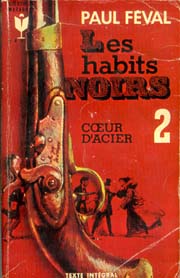 1843
1843
This is the year when the Black Coats try to grab the fortune of the Clare family, after the death of the old Duke
is dead. This marks the debut of the events narrated in Volume 7 - La
Bande Cadet (which will comnclude in 1852), in which the Marquis
de Turpinier, aka Cadet l'Amour, kidnaps Georges,
one of the two possible heirs to the Clare title, and the conclusion of the adventure narrated in Volume 2 - Coeur d'Acier.
Marguerite and her allies (Comayrol, Jaffret, Gioja) are eventually
exposed by Roland Fitz-Roy of Clare, who
has been masquerading as Mr. Coeur, aka Coeur d'Acier,
and Dr. Abel Lenoir. Roland is restored
to his rightful title and inheritance, and marries Nita d'Eppstein. However, unlike what is stated in the book, Marguerite is NOT shot by Joulou, but more likely pardoned off.
In 1852, we will learn that Roland and
Nita were later murdered by the Black
Coats at sone undetermined date, since their estate becomes part of the inheritance coveted by Cadet L'Amour.
This year also sees the conclusion of the adventure narrated in Volume 6 - Les
Compagnons du Trésor.
Vincent Carpentier has returned from exile
and joins forces with his daughter Irene, Reynier,
the man she loves, Maman Léo and
Echalot against the intrigues of both
Cavalier Mora (Julian) and the High Council.
At the end of the year, Marguerite, Dr. Samuel and the other surviving members of the High
Council meet the Colonel (Julian) at the Père Lachaise. He tells them that
he is the true Colonel, and that a lookalike has been buried instead. But they are not fooled and suspect that
this is Mora a.k.a. Julian. They scheme to kill him.
However, Reynier kills Julian. Soon afterwards,
just as the members of the High Council think that they are about to get their hands on the treasure, an explosion
(arranged by Julian) kills and/or maims them. Reynier then goes on to marry Irène.
The death of the Colonel, of Lecoq, the Clare debacle, and this mark the beginning of the decline for the French
branch of the Black Coats. Indeed, no major adventure is recorded until 1852.
1852
This marks the debut of the events narrated in Volume 3 - L'Avaleur
de Sabres, which is the story of Justine
de Vibray, aka the future Mademoiselle
Saphir. That year, young Saladin, a precocious 12-year-old who already works for the Black Coats alongside his father, Similor, kidnaps 2-year-old baby Justine and entrusts
her to Maman Leo.
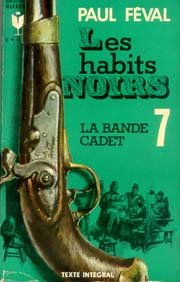 This is also the
year during which the events narrated in Volume 7 - La Bande
Cadet take place. The High Council of the Habits Noirs is now comprised only
of Dr. Samuel, Marguerite, Comayrol, "Goodman" Jaffret and his wife Adele. Adele is, in reality, a cover for an ugly, vicious,
psychopath named the Marquis Tupinier,
a.k.a, Cadet L'Amour. Together, they are
known as la Bande Cadet -- the Cadet Gang.
This is also the
year during which the events narrated in Volume 7 - La Bande
Cadet take place. The High Council of the Habits Noirs is now comprised only
of Dr. Samuel, Marguerite, Comayrol, "Goodman" Jaffret and his wife Adele. Adele is, in reality, a cover for an ugly, vicious,
psychopath named the Marquis Tupinier,
a.k.a, Cadet L'Amour. Together, they are
known as la Bande Cadet -- the Cadet Gang.
Cadet L'Amour has put in motion a new
scheme to steal the Clare fortune. It
relies on killing the true heir who can only be one of the two sons of Angele
Tupinier, who was the wife of the last Duke of Clare. Albert or Georges: one is
the legitimate heir, the other a bastard child (both were born c. 1830), but only Angele knows the truth.
To complicate matters further, we are led to believe that the bastard child's father is Dr.
Abel Lenoir, the sworn enemy of the Black Coats. Cadet L'Amour would kill
both children to be rid of them, but the mysterious Chevalier Mora returns, again posing as the Colonel,
and tells the High Council that one of the two children (it'll turn out to be Albert) is really his and must not
be harmed. This Mora is likely to be Reynier.
In the end, Mora arranges for Cadet to be horribly murdered by one of his earlier victims, putting an end to the
Cadet Gang. We never learn what transpires during a subsequent meeting between him and Marguerite, Comayrol, Dr.
Samuel and Jaffret. Georges, the real Clare heir, survives; however, Albert kills himself when Clotilde, his true love, dies.
Volume 7 reintroduces young would-be policeman named Clampin whose nickname is Pistolet.
Pistolet writes functions here as a private investigator for Dr. Lenoir and the Chevalier Mora.
He is privvy to many of the Black Coats'
secrets. In one of his reports, he write that "since the Colonel's death, the Black Coats are managed almost
as badly as the police."
Untold stories: In Volume 7, Chapter XIX,
Paul Féval revealed that Pistolet
would one day become the Chief of the Surete and reorganize its services along his modern methods, and that his
role would be enshrined in that grand story that would tell of the "final and deadly battle" between
Dr. Abel Lenoir and the Colonel.
 1858
1858
Now begins the conclusion of the adventure narrated in Volume 3 - L'Avaleur
de Sabres. The "Sword Swallower" is Saladin, who worked for the circus and saved the life of Justine, now known as Mademoiselle Saphir,
a rope dancer. Then, life separates them, and nothing more is recorded for eight years.
1866
Saladin returns as the Marquis Franz de Rosenthal, a ruthless and cunning businessman,
still nicknamed the "Sword Swallower" not because of his circus past (unknown to most) but because of
his ability to achieve the impossible. Thanks to Similor,
Saladin locates the rather pitiful remnants of the Black Coats, who now call themselves the Black
Silk Hoods. The High Council is comprised of Dr.
Samuel, Comayrol,
a new Prince and Annibal
Gioja, who now keeps the Scapulary of
Mercy. Marguerite of Clare is dead, but we do not learn the circumstances of her death (which CANNOT be the 1843 debacle
at the Hotel de Clare as actually stated).
Saladin convinces the Black Coats of choosing him as their new Godfather, because he is young, strong, and he has
a plan to steal the Vibray inheritance. They give him the Scapulary, even though they secretly hate him. Gioja
even ends up betraying him. However, Saladin's plans for Justine are thwarted by the return of her father, the
Duke of Chaves. Justine recovers her name,
her inheritance and marries handsome Hector de Sabran.
Saladin, howeer, manages to escape with some loot. The other members of the High Council vanish back into obscurity,
and no more is heard of them.
Note: The Count
of Monte-Cristo (whose appearance in Paris dates back to 1844) is mentioned
in Volume 3 as a real-life character.
Untold stories: Paul Féval promised
future tales of Saladin's criminal career, including the story of "the noble stage where he had the honor
of dying swallowing his last sword."